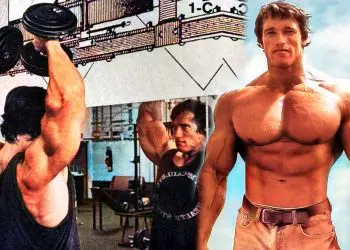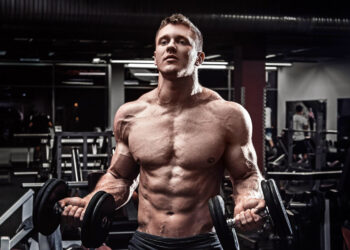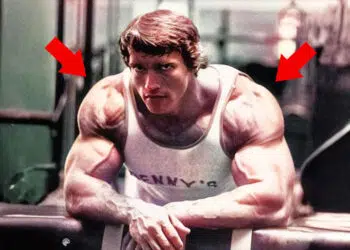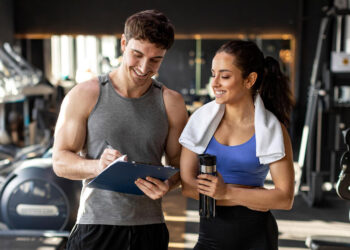The shoulders are among the most eye-catching muscle groups. Whether you are shirtless, wearing a sleeveless T-shirt, or in a business suit, well-developed shoulders stand out a mile. Your shoulders give your upper body its width, contributing to your V-taper. Big shoulders make you look strong and powerful; they command respect!
However, when it comes to shoulder training, many people spend too much time on deltoid isolation exercises like lateral raises, reverse flyes, and external rotations. While there is nothing inherently wrong with these exercises, they might not be the most effective or efficient way to build big shoulders.
Compound exercises like presses and rows put more stress on the target muscles and train those muscles alongside other body parts, making better use of your training time. Plus, no one ever got really strong just doing isolation exercises.
As a personal trainer with over 35 years in the industry, I’ve helped countless people build jacked shoulders. In this article, I reveal the 12 best compound exercises for building stronger, more muscular shoulders and give you a few new workouts to try.
Recent Updates: On May 30, 2024, Fitness Volt’s Senior Editor, Vidur Saini (American Council on Exercise-CPT), updated the article and added actionable expert tips to improve the reader experience. Level Up Your Fitness: Join our 💪 strong community in Fitness Volt Newsletter. Get daily inspiration, expert-backed workouts, nutrition tips, the latest in strength sports, and the support you need to reach your goals. Subscribe for free!
12 Best Compound Shoulder Exercises
Plan your shoulder workouts around the following compound exercises, and it won’t be long before you have to turn sideways to pass through doorways!
- Military press
- Seated barbell overhead press
- Barbell push press
- Bradford press
- Dumbbell shoulder press
- Arnold press
- Seated dumbbell clean and press
- Cuban press
- Wall-facing handstand push-up
- Shoulder press machine
- Landmine half-kneeling shoulder press
- Face pull
1. Military press
| Sets & Reps | Equipment Needed | Target Muscles |
| 3 x 8-12 | Barbell | Anterior Deltoids, Triceps Brachii, Upper Pectoralis Major, Serratus Anterior, Trapezius |
The military press is also known as the strict overhead press. It’s supposed to be performed with straight legs and heels together. However, you probably won’t see many people doing it this way.
“Initiate the press by driving your head through the window created between your upper arms,” recommends Saini. It ensures a vertical bar path and minimizes stress on the shoulder joint.
Steps:
- Hold a barbell in the front rack position.
- Your hands should be slightly wider than shoulder-width apart, with your elbows directly below your hands.
- Stand with your heels together and legs straight.
- Brace your core, pulling your shoulders back and down.
- Without using your legs, press the barbell up and overhead to arm’s length. Drive your head forward as the bar moves upward to keep your body under the center of mass.
- Lower the bar back to your shoulders and repeat.
Coach Tips:
- Use a thumbless grip if you find military presses bother your shoulders.
- Wear wrist wraps to support your wrists if required.
- You can also do this exercise with dumbbells.
| Difficulty | Progression | Regression |
| Intermediate | Increase weight | Use a Smith machine, seated military press |
2. Seated barbell overhead press
| Sets & Reps | Equipment Needed | Target Muscles |
| 3 x 8-12 | Barbell, Bench | Anterior Deltoids, Triceps Brachii, Upper Pectoralis Major, Medial Deltoids, Rotator Cuffs |
While the military press is designed to stop you from using your lower body to lift the weight, some people still cheat by pushing with their legs. Seated barbell overhead presses remove your legs from the movement, making it a much stricter exercise. However, you’ll also find that you won’t be able to lift as much weight.
Saini prescribes maintaining a neutral spine throughout the exercise to limit lower back strain.
Steps:
- Sit on your bench with your back upright and feet flat on the floor.
- Hold your barbell across the front of your shoulders with an overhand, slightly wider than shoulder-width grip.
- Brace your core and pull your shoulders down and back.
- Press the barbell overhead to arm’s length. Do not lock your elbows.
- Lower the bar back to your shoulders and repeat.
Coach Tips:
- You can also do this exercise with dumbbells instead of a barbell.
- Use a bench with back support or sit on a flat bench without back support as preferred.
- Experiment with a wider or narrower grip to see which you prefer.
| Difficulty | Progression | Regression |
| Intermediate | Perform standing | Use a Smith machine, decrease weight |
3. Barbell push press
| Sets & Reps | Equipment Needed | Target Muscles |
| 3 x 6-8 | Barbell | Anterior Deltoids, Triceps Brachii, Upper Pectoralis Major, Quadriceps, Gluteus Maximus |
While military presses and seated overhead presses discourage lower body use, barbell push presses actively involve leg drive to help you lift heavier loads. Think of the push-press as strategic cheating and an excellent way to develop your upper body strength and pushing power.
Synchronizing hip drive with the moment the barbell leaves the shoulders ensures maximal power generation and explosiveness, says Saini.
Steps:
- Rest and hold a barbell across the front of your shoulders. Your hands should be a little wider than shoulder-width apart, with your elbows directly below your hands.
- Stand with your feet around shoulder-width apart, knees slightly bent.
- Brace your core, and pull your shoulders back and down.
- Bend your knees and descend into a quarter-depth squat.
- Explosively extend your legs and use this power to help push the weight overhead to arm’s length.
- Drive your head forward as the bar moves upward to keep your body under the center of mass.
- Lower the bar back to your shoulders, reset your core and repeat.
Coach Tips:
- Transition from strict overheard presses to push presses to extend your set beyond failure.
- You can also do push presses with dumbbells instead of a barbell.
- This exercise works best when done for low to moderate reps with medium to heavy weights, e.g., 4-8 per set.
- Wear a weightlifting belt to protect and support your lower back.
| Difficulty | Progression | Regression |
| Intermediate | Increase weight, perform a jerk | Overhead press, dumbbell push press |
4. Bradford press
| Sets & Reps | Equipment Needed | Target Muscles |
| 3 x 10-15 | Barbell | Anterior Deltoids, Lateral Deltoids, Triceps Brachii |
Named after Olympic athlete Jim Bradford, this unusual compound shoulder exercise combines front and behind-the-neck presses. It keeps your shoulders under constant tension, making it excellent for hypertrophy. However, you will need healthy, mobile shoulders to perform it correctly.
Saini suggests using light weights, preferably only a 45-pound barbell, for this exercise to avoid unnecessary shoulder strain.
Steps:
- Hold a barbell in front of your upper chest with a slightly wider than shoulder-width grip so your elbows are directly below your hands.
- Pull your shoulders down and back, and brace your abs.
- Press the bar up so that it’s just level with the top of your head, and then lower it down behind your neck.
- Next, press the bar up and off your neck and return to the starting position. The bar should just clear the top of your head. Do not lock out your arms.
- That’s one rep.
Coach Tips:
- This exercise works best with light to moderate weights and medium to high reps, e.g., 8-15.
- Perform this exercise standing or seated as preferred.
- Try both a medium and a wider grip to see which you prefer.
| Difficulty | Progression | Regression |
| Intermediate | Increase weight, slow negatives | Use dumbbells |
5. Dumbbell shoulder press
| Sets & Reps | Equipment Needed | Target Muscles |
| 3 x 8-12 | Dumbbells | Anterior Deltoids, Lateral Deltoids, Posterior Deltoid, Rotator Cuffs, Triceps Brachii |
While barbell presses are a great way to overload your deltoids, they can be hard on your shoulder joints. Barbell presses force you into a rigid hand position and movement pattern, which some people find uncomfortable. Switching to dumbbells allows you to move your limbs more naturally and adapt overhead presses to your unique biomechanics.
“Bring the dumbbells together during the lifting phase for a peak deltoid contraction at the top of your range of motion (ROM),” says Saini.
Steps:
- Hold a pair of dumbbells at shoulder level with your palms facing forward. Brace your abs and pull your shoulders down and back.
- Press the weights up and overhead, so they come together at arm’s length.
- Lower the dumbbells back to your shoulders and repeat.
Coach Tips:
- You can do dumbbell overhead presses seated or standing as preferred.
- Some people find a neutral (palms turned inward) grip more comfortable.
- Use an alternating arm action to keep your muscles under tension for longer, like this:
| Difficulty | Progression | Regression |
| Beginner | Perform alternately | Machine shoulder press |
6. Arnold press
| Sets & Reps | Equipment Needed | Target Muscles |
| 3 x 8-12 | Dumbbells | Anterior Deltoids, Lateral Deltoids, Posterior Deltoid, Rotator Cuffs, Triceps Brachii |
The Arnold press is named after the legendary bodybuilder Arnold Schwarzenegger. It’s designed to hit all three deltoid heads. However, the anterior deltoid is still doing the majority of the work. Arnie had epic shoulders, and he credits this exercise as one of the reasons why.
“As you press upwards, visualize screwing the dumbbells into the ceiling by externally rotating your shoulders,” cues Saini. It will help boost your mind-muscle connection and maximize deltoid activation.
Steps:
- Hold a dumbbell in each hand at shoulder level, arms bent, and palms facing your body.
- Bring your arms in and together in front of your chest.
- Next, open your arms and then press the weights up and overhead, externally rotating your wrists.
- Lower the weights, move your arms in and out again, and then repeat.
Coach Tips:
- This exercise works best with light to moderate weights and medium to high reps, e.g., 8-15.
- Stop immediately if you feel shoulder discomfort.
| Difficulty | Progression | Regression |
| Beginner | Increase weight, perform standing | Seated dumbbell press |
7. Seated dumbbell clean and press
| Sets & Reps | Equipment Needed | Target Muscles |
| 3 x 8-15 | Dumbbells | Anterior Deltoids, Lateral Deltoids, Triceps Brachii, Trapezius, Rotator Cuffs |
The seated dumbbell clean and press is a straightforward but demanding shoulder exercise that will push your deltoids to their limit. Expect a deep pump and excruciating burn from this unique movement. Seated dumbbell clean and presses will build strength, size, and power in equal measure!
Saini suggests using a hook grip (thumb under the fingers) during the clean portion to strengthen your grip, allowing you to handle heavier weights.
Steps:
- Sit on the end of a flat exercise bench with a dumbbell in each hand, arms down by your sides.
- Lean forward slightly, lowering the weights down toward the floor, and then sit up explosively.
- Use this momentum to help you raise the dumbbells to shoulder height, flipping them, so your elbows are directly beneath your hands.
- Push the weights overhead.
- Lower the dumbbells back to your shoulders and then down to your side.
- Repeat for the required number of reps.
Coach Tips:
- Press the weights only halfway up to maintain constant tension on your deltoids.
- This exercise works best with light to moderate weights and medium to high reps, e.g., 8-15. Go for the burn, man!
| Difficulty | Progression | Regression |
| Intermediate | Perform standing | Seated dumbbell press |
8. Cuban press
| Sets & Reps | Equipment Needed | Target Muscles |
| 3 x 10-12 | Barbell or Dumbbells | Anterior Deltoids, Lateral Deltoids, Trapezius, Rhomboids, Biceps Brachii, Triceps |
The Cuban press comes from Olympic weightlifting and is one of the exercises the Cuban team uses to reduce the risk of shoulder injuries. However, this is not just a shoulder health exercise; it’s also an effective deltoid builder for all three heads. Don’t go too heavy too soon with this exercise — it’s much more challenging than it looks!
Steps:
- Hold a barbell against your thighs with an overhand, slightly wider than shoulder-width grip.
- Stand with your feet hip-width apart, knees slightly bent, core braced, and shoulders down and back.
- Bend your elbows and pull the barbell up to your lower chest. Your upper arms should be parallel to the floor.
- Next, externally rotate your arms and raise the bar to just above your head.
- Press the bar up to arm’s length.
- Lower the bar back to your head, rotate the bar down to your sternum and return the bar to hip height.
- That’s one rep.
Coach Tips:
- Do just the first part of the exercise and skip the overhead press to focus more on your medial and posterior deltoids.
- You can also do this exercise with dumbbells like this:
| Difficulty | Progression | Regression |
| Beginner | Increase weight, slow negatives | Use dumbbells, decrease weight, lateral dumbbell raise |
9. Wall-facing handstand push-up
| Sets & Reps | Equipment Needed | Target Muscles |
| 3 x Max Reps | None | Anterior Deltoids, Medial Deltoids, Triceps Brachii, Upper Pectoralis Major, Serratus Anterior |
Unless you’re a gymnast, you’ll probably need to do this exercise against a wall for balance. However, it’s still a very effective shoulder builder, even with the added support. Maybe one day you’ll be able to do them without the wall.
Saini suggests protracting your shoulders by rounding your upper back slightly at the bottom of the movement to increase the range of motion and maximize target muscle fiber recruitment.
Steps:
- Stand with your back to a smooth, clear wall. Squat down and place your hands on the floor, roughly shoulder-width apart.
- Place your feet against the wall, and then walk your feet up until your legs are straight. Brace your core.
- Move your hands back toward the wall until your body is close to vertical.
- Bend your arms and lower the top of your head to the floor.
- Push back up and repeat.
Coach Tips:
- Take your shoes off, so your feet slide more easily against the wall.
- Raise your hands on parallettes or push-up bars to increase your range of motion.
- This is a strenuous exercise, so only attempt it if you are close to being able to press your body weight overhead.
| Difficulty | Progression | Regression |
| Advanced | Perform freestanding, deficit handstand push-ups | Pike push-ups, incline pike push-ups, box pike push-ups |
10. Shoulder press machine
| Sets & Reps | Equipment Needed | Target Muscles |
| 3 x 8-12 | Shoulder Press Machine | Anterior Deltoids, Lateral Deltoids, Triceps Brachii |
A lot of trainers are very down on the shoulder press machine. They say it’s not very functional and, in some way, inferior to free weight and bodyweight exercises. However, machine presses can actually be advantageous when you’re training for hypertrophy as they eliminate balance and coordination and leave you free to focus on pushing your deltoids to their limit in relative safety.
“Adjust the seat height so that the handles are aligned with your shoulders when your arms are bent at 90 degrees,” says Saini. ROM is key when performing machine exercises.
Steps:
- Grab the handles and pull your shoulders down and back.
- Push the handles up to arm’s length. Do not lock your elbows.
- Bend your elbows to lower the weights, but don’t let the plates hit the stack.
- Push your arms back up and repeat.
Coach Tips:
- Shoulder press machines can vary in design, so make sure you use the one in your gym according to the manufacturer’s instructions.
- Pump out reps until you reach muscular failure, reduce the weight by 10-20%, and then do a few more reps. This is called a drop set and is an excellent training method for machine-based exercises.
- Most shoulder press machines offer narrow, wide, and parallel grips, so try them all to see which one you prefer.
| Difficulty | Progression | Regression |
| Beginner | Increase weight, slow eccentrics | Use dumbbells |
11. Landmine half-kneeling shoulder press
| Sets & Reps | Equipment Needed | Target Muscles |
| 3 x 8-12 per side | Landmine attachment, Barbell | Anterior Deltoids, Lateral Deltoids, Triceps Brachii, Core |
Some lifters report that overhead pressing hurts their shoulders. In fact, there are plenty of people who are no longer able to do conventional overhead presses because of shoulder pain. The landmine shoulder press is much more joint-friendly, and the angled movement tends to be well-tolerated by people with banged-up shoulders.
The half-kneeling position removes your legs from the exercise, so you won’t be able to lift as much weight or cheat, making it even better for your joints.
Steps:
- Kneel at the end of your landmine bar with your left leg forward and your right leg back. Both knees should be bent to 90 degrees. Hold the end of the bar at shoulder height in your right hand, with your palm facing inward.
- Brace your core and make sure your torso is perfectly vertical.
- Press the bar up and slightly forward, leaning into the movement.
- Lower your hand back to your shoulder and repeat.
- Rest a moment, swap sides, and repeat.
Coach Tips:
- You can also do this exercise while standing, but don’t use your legs too much.
- Do this exercise bilaterally by using two landmine devices.
- Grip the handle with both hands to train both sides simultaneously, like this:
| Difficulty | Progression | Regression |
| Beginner | Increase weight, use both arms simultaneously | Seated landmine press |
12. Face pull
| Sets & Reps | Equipment Needed | Target Muscles |
| 3 x 15-20 | Cable Machine, Rope Attachment | Posterior Deltoids, Rhomboids, Middle Trapezius |
As you will surely have noticed, most compound shoulder exercises emphasize the anterior or front deltoids. That’s because the majority of them are pressing exercises. However, a few compound exercises target the posterior deltoids, and face pulls are arguably one of the best. Do this exercise to balance out all the anterior deltoid work you’ve been doing.
Level Up Your Fitness: Join our 💪 strong community in Fitness Volt Newsletter. Get daily inspiration, expert-backed workouts, nutrition tips, the latest in strength sports, and the support you need to reach your goals. Subscribe for free!
Saini recommends pausing at the top of your ROM and squeezing your shoulder blades together to maximize rear delt activation.
Steps:
- Set a cable pulley to shoulder height. Attach a rope handle and take one end in each hand. With your arms straight, step back and into a staggered stance. Pull your shoulders back and down, and tense your core.
- Bend your arms and pull the handles toward your head. Imagine you are trying to poke your thumbs in your ears.
- Extend your arms and repeat.
Coach Tips:
- You can also do this exercise in a seated or half-kneeling position to separate your upper body from your legs.
- You can do band pull-aparts to train the same muscles without using your biceps.
- No cable machine? Try resistance band face pulls:
| Difficulty | Progression | Regression |
| Beginner | Increase weight, slow negatives | Use resistance bands |
Read also: Face pull guide.
3 Compound Shoulder Workouts to Try
Build your deltoids with one of our tried and tested workouts!
Workout 1: Barbell-only
| # | Exercise | Sets | Reps | Recovery |
| 1 | Seated barbell overhead press | 4 | 8-12 | 90 seconds |
| 2 | Bradford press | 3 | 8-12 | 90 seconds |
| 3 | Cuban press | 3 | 12-15 | 90 seconds |
| 4 | Wide grip bent-over row | 3 | 12-15 | 90 seconds |
Workout 2: Dumbbells and body weight
| # | Exercise | Sets | Reps | Recovery |
| 1 | Arnold press | 4 | 8-12 | 90 seconds |
| 2 | Seated dumbbell clean and press | 3 | 6-8 | 2 minutes |
| 3 | Prone incline dumbbell press | 3 | 12-15 | 60 seconds |
| 4 | Handstand push-up | 2 | AMRAP | 60 seconds |
AMRAP = As Many Reps as Possible
Workout 3: The kitchen sink
| # | Exercise | Sets | Reps | Recovery |
| 1 | Military press | 2 | 4-6 | 2 minutes |
| 2 | Barbell push press | 2 | 4-6 | 2 minutes |
| 3 | Dumbbell shoulder press | 2 | 8-10 | 90 seconds |
| 4 | Landmine shoulder press | 2 | 8-10 | 90 seconds |
| 5 | Pike push-up | 2 | AMRAP | 60 seconds |
| 6 | Shoulder press machine | 2 | 12-15 | 60 seconds |
AMRAP = As Many Reps as Possible
Shoulder Anatomy Basics
While you don’t need an extensive knowledge of anatomy and physiology to build massive shoulders, a basic understanding of how the shoulders work makes it easier to pick the best exercises for your goals.
Here are the three distinct deltoid muscles or heads you should know about:
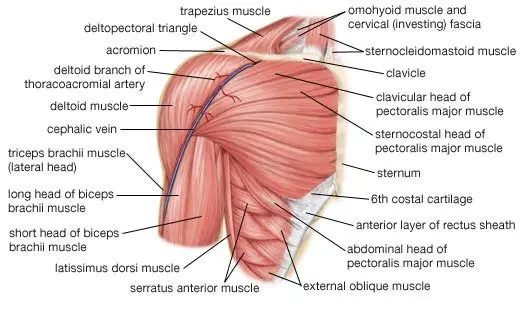
Anterior deltoid
Located at the front of your shoulder joint, the anterior deltoid is involved in every overhead and pressing exercise you do. Its functions include flexion and medial rotation of the shoulder joint.
Medial deltoid
The medial deltoid head gives your shoulders their width. Located on the side of your shoulder, it abducts your shoulder joint, lifting your upper arm out and away from your side.
Posterior deltoid
The posterior deltoid opposes the anterior deltoid and performs the opposite functions. Located on the back of your shoulder, the posterior or rear deltoid extends and externally rotates your shoulder joint.
The posterior deltoid is often underdeveloped. This is because it’s involved in fewer exercises. Don’t worry, though; we’ve got a few compound posterior deltoid exercises to share with you!
Rotator cuff
Beneath your deltoids is a group of muscles collectively called the rotator cuff. While these muscles don’t contribute to the size of your shoulders, they’re crucial for shoulder joint health. They are involved in all shoulder exercises, usually in a synergistic (assistance) role or as stabilizers.
The muscles of the rotator cuff are:
- Teres Minor
- Supraspinatus
- Subscapularis
- Infraspinatus
FAQs
1. How do I train my medial deltoids with compound shoulder exercises?
We’ve got good news and bad news. The good news is that your medial delts are involved in most compound shoulder exercises. However, the bad news is that they mostly work in a secondary role and are not the target muscle. This means they may not get the attention they deserve if your workouts only involve compound movements.
The best way to develop your medial deltoids is with abduction exercises where you lift your upper arm away from your sides, e.g., dumbbell, cable, and machine side raises.
So, supplement your compound deltoid workouts with some type of side raise to ensure your medial deltoids are as well developed as possible.
2. Some of these exercises bother my shoulders. What can I do?
Shoulder pain is a common problem for lifters. Exercises like overhead and bench presses can be tough on your joints. If ignored, shoulder pain can become so bad that you cannot do any upper-body training.
If any of these exercises cause joint pain, first ensure you are performing them properly and not using too much weight. Then eliminate any movements that put your shoulders into an awkward position, such as Bradford presses.
If you’re still in pain, get it checked out, as it could be a sign that something is wrong and needs treatment.
3. Are overhead presses all I need to build big, powerful shoulders?
Overhead presses will undoubtedly turn your little shoulders into muscular cannonballs. However, presses also tend to emphasize your anterior deltoids and aren’t as effective for targeting your medial and posterior deltoids.
So, while overhead presses will give you big shoulders, if you want sculpted, well-shaped delts, you should also do some work for the medial and posterior heads. This is easily done by adding some cable and dumbbell exercises to your shoulder routine, e.g.;
| # | Exercise | Sets | Reps | Recovery |
| 1 | Z press | 4 | 6-8 | 2 minutes |
| 2 | Dumbbell shoulder press | 3 | 8-10 | 90 seconds |
| 3 | Cable face pull | 3 | 10-12 | 60 seconds |
| 4 | Dumbbell lateral raise | 3 | 10-12 | 60 seconds |
4. How often should I train my shoulders?
Muscles usually respond well to two weekly workouts, e.g., Monday and Friday. Doing two sessions rather than one means you don’t have to cram all your exercises and sets into one huge workout.
Plus, planning for two workouts means that, if you miss one, you still have one training session to maintain your progress.
However, it’s also worth noting that your shoulders are involved in all your chest and back workouts, albeit indirectly. As such, you may not need the full two sessions unless your shoulders are particularly underdeveloped.
So, start with one shoulder workout per week, and then add another if you feel you are progressing too slowly.
Related:
- Best Rear Delt Dumbbell Exercises
- Best Shoulder and Bicep Workout for Strength and Size
- Best Deltoid Workouts and Exercises Using Machines to Sculpt Huge Shoulders
- Best Shoulder Isolation Exercises For Bigger and Peeled Deltoids
- At-Home Shoulder Exercises For Big Gains
- The 21 Best Shoulder Exercises For Big, Powerful Delts
Closing thoughts
When it comes to back training, bodybuilders often say that if you want to grow, you gotta row. Unfortunately, they don’t have a similar saying for shoulder training. Still, if they did, it would probably be something like, if you want your delts to be the best, you gotta press!
Compound exercises are arguably the best use of your training time. They involve multiple muscle groups and train your body as it works in nature. They’re perfect for building muscle size and strength and should be the cornerstone of your workouts.
That said, you don’t have to go all compound all the time. In fact, using shoulder isolation exercises will allow you to target each deltoid with laser-like precision, which is useful if your rear or medial delts need extra attention.
It’s popular to say that you only need compound exercises to build a fantastic physique, but that’s not always true. In some cases, isolation exercises can be beneficial, too, especially if you value aesthetics as well as performance and brute strength.


